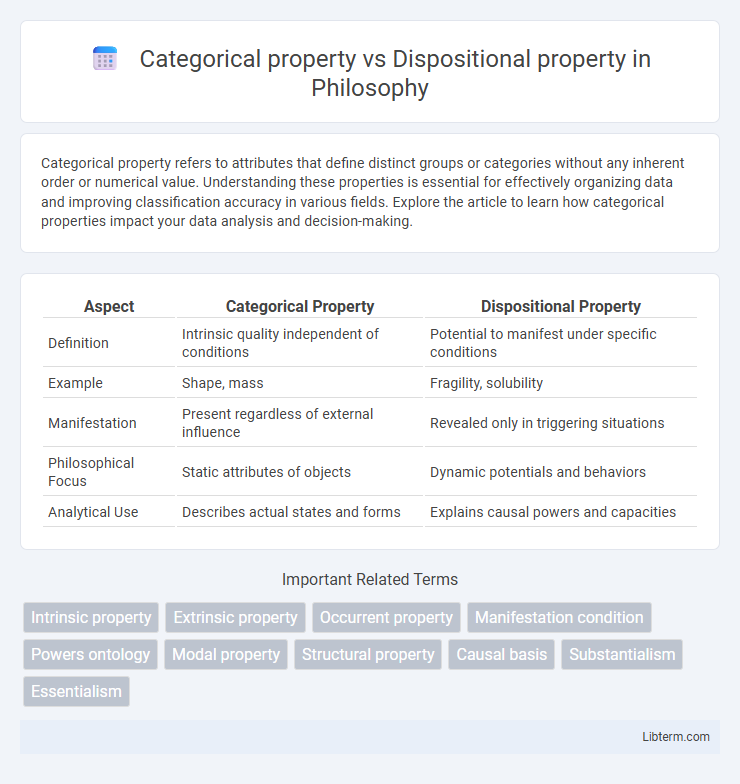Categorical property refers to attributes that define distinct groups or categories without any inherent order or numerical value. Understanding these properties is essential for effectively organizing data and improving classification accuracy in various fields. Explore the article to learn how categorical properties impact your data analysis and decision-making.
Table of Comparison
| Aspect | Categorical Property | Dispositional Property |
|---|---|---|
| Definition | Intrinsic quality independent of conditions | Potential to manifest under specific conditions |
| Example | Shape, mass | Fragility, solubility |
| Manifestation | Present regardless of external influence | Revealed only in triggering situations |
| Philosophical Focus | Static attributes of objects | Dynamic potentials and behaviors |
| Analytical Use | Describes actual states and forms | Explains causal powers and capacities |
Introduction to Categorical and Dispositional Properties
Categorical properties refer to qualities or features that an object possesses independently of any potential effects or uses, such as the shape or mass of an object. Dispositional properties describe tendencies or capacities for an object to behave in certain ways under specific conditions, like fragility or solubility. Understanding the distinction between categorical and dispositional properties is essential in fields such as metaphysics and philosophy of science, as it influences how objects and their interactions are conceptualized.
Defining Categorical Properties
Categorical properties are defining features inherent to an object, existing independently of any conditions or potential changes, such as the mass or shape of a physical entity. They contrast with dispositional properties, which depend on the object's capacities or tendencies to behave in certain ways under specific circumstances, like fragility or solubility. Understanding categorical properties involves recognizing the object's qualitative aspects that do not rely on external factors or possible future states.
Defining Dispositional Properties
Dispositional properties refer to the inherent tendencies or capabilities of an entity to exhibit certain behaviors or effects under specific conditions, such as fragility or solubility. Unlike categorical properties, which describe static qualities independent of external circumstances, dispositional properties are essentially potentialities that manifest when triggered. These properties are central to understanding objects' interactions and responses within their environment, reflecting a dynamic aspect of their nature.
Historical Background of Property Distinctions
The distinction between categorical and dispositional properties has its roots in early modern philosophy, notably in the works of John Locke and David Hume, who explored the nature of qualities and their relation to objects. Categorical properties are understood as intrinsic features that an object possesses independently of any potential interactions, whereas dispositional properties relate to tendencies or capacities that manifest under certain conditions. This historical dichotomy laid the groundwork for contemporary metaphysical debates on the essence and manifestation of properties within objects.
Key Differences Between Categorical and Dispositional Properties
Categorical properties refer to the inherent, static qualities of an object, such as its shape or mass, while dispositional properties denote potential behaviors or tendencies, like fragility or solubility. Key differences include that categorical properties exist independently of conditions, whereas dispositional properties depend on specific circumstances or interactions to manifest. Understanding these distinctions is crucial in fields like metaphysics and philosophy of science for classifying and explaining object behaviors.
Philosophical Theories on Properties
Categorical properties are intrinsic qualities that an object possesses independently of any potential manifestations, emphasizing the object's actual state as defined in philosophical theories such as Aristotelian realism. Dispositional properties, conversely, are defined by the potential behaviors or responses an object can exhibit under certain conditions, as explored in tropes theory and modal realism. The debate between categorical and dispositional properties remains central to metaphysical discussions on the nature of properties and their roles in explaining causation and identity.
Examples of Categorical Properties in Nature
Categorical properties in nature include the density of water, the hardness of diamond, and the color of a leaf, as these attributes exist independently of any conditions or potential behaviors. These properties are intrinsic and measurable, such as the melting point of ice or the atomic structure of a crystal. Unlike dispositional properties, categorical properties remain constant regardless of external influences or future occurrences.
Examples of Dispositional Properties in Nature
Dispositional properties, such as fragility in glass, solubility in salt, and combustibility in wood, describe tendencies or capacities that manifest under specific conditions. Unlike categorical properties, which define the intrinsic qualities of an object independent of external influences, dispositional properties highlight potential behaviors triggered by interactions with environmental factors. These examples demonstrate how natural substances carry inherent capabilities that reveal themselves only when activated by appropriate stimuli.
Implications for Metaphysics and Science
Categorical properties, defined by their intrinsic qualities independent of any effects, challenge metaphysical views by emphasizing a reality grounded in actual attributes rather than potentialities. Dispositional properties, characterized by their tendencies or powers to produce certain effects, influence scientific explanations by highlighting predictive and causal relationships in natural phenomena. The interplay between these property types shapes debates on causation, object persistence, and the nature of laws in both metaphysical theory and scientific practice.
Conclusion: Relevance of Property Distinctions
Categorical properties, defining an object's actual qualities independent of interactions, contrast with dispositional properties, which relate to potential behaviors under specific conditions. Understanding the distinction between categorical and dispositional properties enhances analyses in metaphysics, science, and philosophy by clarifying how objects manifest characteristics or causal powers. This distinction proves crucial for developing theories of causation, intrinsic nature, and the interpretation of scientific properties.
Categorical property Infographic

 libterm.com
libterm.com